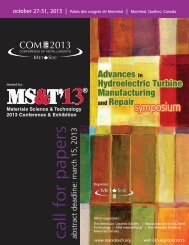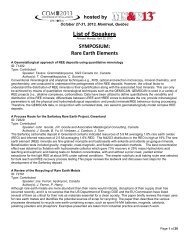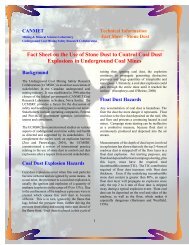Reasonable prospects for economic extraction – additional guidance
Reasonable prospects for economic extraction – additional guidance
Reasonable prospects for economic extraction – additional guidance
You also want an ePaper? Increase the reach of your titles
YUMPU automatically turns print PDFs into web optimized ePapers that Google loves.
Additional Guidance - <strong>Reasonable</strong> <strong>prospects</strong> <strong>for</strong> <strong>economic</strong> <strong>extraction</strong> <strong>–</strong><br />
December 15, 2009<br />
In a letter dated June 17, 2009 to the CSA-CIM Working Committee, the British<br />
Columbia Securities Commission, on behalf of the CSA NI 43-101 Revision Committee,<br />
requested CIM to consider several issues associated with the reporting of Resources and<br />
Reserves. In particular, CSA asked CIM to consider providing <strong>additional</strong> <strong>guidance</strong> on<br />
how qualified persons should determine reasonable <strong>prospects</strong> of <strong>economic</strong> <strong>extraction</strong> <strong>for</strong><br />
the purposes of establishing mineral resources. CSA made this request in response to<br />
industry feedback it received during its recent NI 43-101 consultation process. The CIM<br />
Reserve Definitions Committee (the Committee) has reviewed the request to provide<br />
<strong>additional</strong> <strong>guidance</strong> on the “reasonable <strong>prospects</strong> <strong>for</strong> <strong>economic</strong> <strong>extraction</strong>” clause in the<br />
CIM Definition Standards and has reported on our finding below. The two relevant<br />
paragraphs of the December 11, 2005 CIM Definition Standards have been included<br />
below <strong>for</strong> reference.<br />
“A Mineral Resource is a concentration or occurrence of diamonds, natural solid<br />
inorganic material, or natural solid fossilized organic material including base and<br />
precious metals, coal, and industrial minerals in or on the Earth‟s crust in such<br />
<strong>for</strong>m and quantity and of such a grade or quality that it has reasonable <strong>prospects</strong><br />
<strong>for</strong> <strong>economic</strong> <strong>extraction</strong>. The location, quantity, grade, geological characteristics<br />
and continuity of a Mineral Resource are known, estimated or interpreted from<br />
specific geological evidence and knowledge.”<br />
“The term Mineral Resource covers mineralization and natural material of intrinsic<br />
<strong>economic</strong> interest which has been identified and estimated through exploration and<br />
sampling and within which Mineral Reserves may subsequently be defined by the<br />
consideration and application of technical, <strong>economic</strong>, legal, environmental, socio<strong>economic</strong><br />
and governmental factors. The phrase „reasonable <strong>prospects</strong> <strong>for</strong> <strong>economic</strong><br />
<strong>extraction</strong>‟ implies a judgment by the Qualified Person in respect of the technical<br />
and <strong>economic</strong> factors likely to influence the prospect of <strong>economic</strong> <strong>extraction</strong>. A<br />
Mineral Resource is an inventory of mineralization that under realistically assumed<br />
and justifiable technical and <strong>economic</strong> conditions might become <strong>economic</strong>ally<br />
extractable. These assumptions must be presented explicitly in both public and<br />
technical reports.”<br />
The above <strong>guidance</strong> indicates that when assessing „reasonable <strong>prospects</strong> <strong>for</strong> <strong>economic</strong><br />
<strong>extraction</strong>‟:<br />
<br />
<br />
<br />
It is the responsibility of the Qualified Person<br />
It requires judgment based on the Qualified Person‟s experience<br />
The methods used and assumptions made to determine if the project has<br />
“reasonable <strong>prospects</strong>” must be presented explicitly in both public and technical<br />
reports.<br />
Additional Guidance is provided in the CIM Best Practice Guidelines <strong>for</strong> the Estimation<br />
of Mineral Resources and Mineral Reserves under Section 4, Geological Interpretation<br />
and Modeling, Mining and Economic Requirements and Section 5, Mineral Resource<br />
Estimation. This <strong>guidance</strong> indicates that, when considering „reasonable <strong>prospects</strong> <strong>for</strong><br />
<strong>economic</strong> <strong>extraction</strong>‟:
Factors significant to <strong>extraction</strong> including mining, processing, marketing,<br />
environmental, social, legal and <strong>economic</strong> aspects must be considered in both<br />
Mineral Resource and Mineral Reserve estimates<br />
For Mineral Resources, risk factors significant to the project <strong>economic</strong>s should be<br />
clearly defined, current, reasonably developed and based on generally accepted<br />
industry practice and experience.<br />
For Mineral Reserves, parameters developed must be detailed with engineering<br />
complete to Preliminary Feasibility standards as defined in the CIM Standards <strong>for</strong><br />
Mineral Resources and Reserves.<br />
Cut-off grade or cut-off net smelter return (NSR) used <strong>for</strong> (both) Mineral<br />
Resource and Mineral Reserve reporting are largely determined through the<br />
application of reasonable long term metal prices.<br />
Additional Guidance<br />
In regard to the statement above, that long term prices be used to determine cut-off grade,<br />
further <strong>guidance</strong> has been developed and included on the CIM website [see „Questions<br />
resulting from CSA-CIM Committee Meetings (April 14, 2008)]. In providing<br />
„<strong>additional</strong> <strong>guidance</strong>‟ <strong>for</strong> the estimation of Mineral Resources, the Committee suggests<br />
that:<br />
<br />
<br />
The QP should be guided by his or her own experience with respect to the<br />
development of reasonably based geological, mining, processing, marketing,<br />
environmental, legal, social and <strong>economic</strong> parameters <strong>for</strong> the determination of<br />
gross scale project <strong>economic</strong>s. If the QP‟s experience is sufficiently broad, then<br />
an individual QP should be seen as capable of determining „reasonable <strong>prospects</strong><br />
<strong>for</strong> <strong>economic</strong> <strong>extraction</strong>‟ at the mineral resource estimation stage of a project. For<br />
example, a QP with sufficient experience to classify him or her self as an<br />
„<strong>economic</strong> geologist‟ may consider his or her experience sufficiently broad<br />
whereas an exploration geologist might not. The QP should be satisfied the<br />
chosen parameters are reasonable and the resulting mineral resource estimate has<br />
“reasonable <strong>prospects</strong> <strong>for</strong> <strong>economic</strong> <strong>extraction</strong>”.<br />
If the QP does not have sufficiently broad experience to develop the requisite<br />
reasonably based parameters, then the QP should consult other QPs to augment<br />
his or her experience in determining „reasonable <strong>prospects</strong> <strong>for</strong> <strong>economic</strong><br />
<strong>extraction</strong>”.<br />
Since the assessment of „reasonable <strong>prospects</strong> <strong>for</strong> <strong>economic</strong> <strong>extraction</strong>‟ is central to<br />
disclosing a mineral resource, the QP must outline the method adopted (NI 43-101,<br />
Section 3.4c) when providing written disclosure.<br />
The Committee would like to reference an article written by Messrs. G. Gossan and L.B.<br />
Smith that was published in the CIM Magazine Volume 2, No. 8 pp 70-71 and entitled<br />
<strong>Reasonable</strong> Prospects <strong>for</strong> Economic Extraction, as providing <strong>additional</strong> relevant<br />
background <strong>for</strong> the QP in regard to deposits amenable to open pit <strong>extraction</strong>.<br />
The Committee considers that the use of mine planning tools, such as open pit design<br />
algorithms, to limit the extent of mineralization is valid <strong>for</strong> advanced Mineral Resource<br />
statements and Mineral Reserves but it may not be appropriate, or required, <strong>for</strong> earlier<br />
stage Mineral Resource statements. For early stage assessments the QP may choose to<br />
demonstrate „reasonable <strong>prospects</strong> <strong>for</strong> <strong>economic</strong> <strong>extraction</strong>‟ by comparing the deposit‟s<br />
attributes to analogous mine operations.



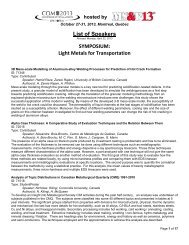

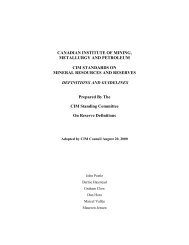
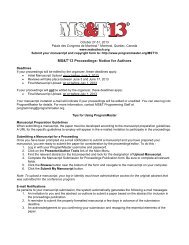


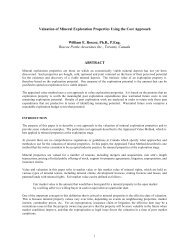
![Richard Wright - NORWEST Corporation [PDF]](https://img.yumpu.com/34320526/1/190x245/richard-wright-norwest-corporation-pdf.jpg?quality=85)
